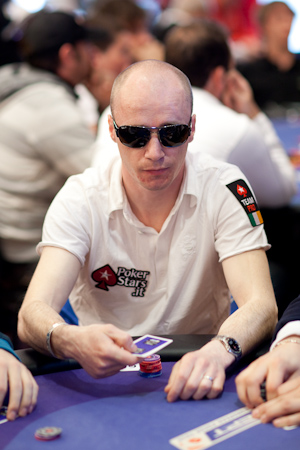|
|

Short Stack - A player who has fewer chips than the other players at the table, or has proportionally low amount
of chips compared to the cost of the blinds.
In tournament play, the size of a player’s stack is judged not by its dollar amount, by its relative size when compared with the cost
of the blinds every round. As the blinds increase, a player’s stack must also increase in order to retain its
value. The dollar amount
of a player’s stack is completely irrelevant unless it is considered in conjunction with the per round cost of blinds and antes. Since
there is a close relationship between the value of a player’s stack and the size of the blinds, tournament players often describe
their stack in multiples of the big blind, rather than in specific dollar amounts, corresponding with specific blind levels.
Tournament players understand that the value of their stack is a function of the size of the blinds. As the blinds increase, they must
add to their stack at an increasing rate, or they will become short stacked. Being short stacked in a tournament is a huge
disadvantage. It severely limits your betting options, and often requires you to risk all of your chips in order to
draw. It also makes it more difficult to defend your
blinds, and makes you more susceptible to
bluffs. It is also less risky for your opponents to
steal from you when you are short stacked because you
can’t hit them that hard. Because of this, when tournament players get short stacked, they often will elect to “take a stand” with a less
than premium hand in an attempt to acquire chips.
There is no explicitly stated ratio of stack size to blind size which defines a short stack, but having a stack of at least ten times
the amount of the large blind is widely considered a critical level of support. If your stack drops below ten times the big blind, you
are under a lot of pressure to make a hand relatively quickly. This is especially true if there are antes in play as well as blinds.
When antes are in play in addition to blinds, a stack of ten times the big blind is considered extremely short stacked, while ten
times the total cost per round (blinds plus antes) would be considered a critical support level. Many players describe the situation
of being short stacked as being “critical,” “desperate,” or “on life support.”
It is a disadvantage to get short stacked, but it is a much bigger disadvantage to get your chips in with the worst of it. Tournaments
are primarily about risk management. They last a long time, from several hours to several days. If you want to have success you have
to avoid excessive risk, and you have to avoid taking the worst of it. This means that your primary obligation is to risk management
and survival, and your secondary obligation is to building stack. Often, when you get short stacked in a tournament, there is not very
much you can do about it. On the bright side, there are some advantages to being short stacked, even though on the balance, it is
definitely a disadvantage. One advantage that a short stack carries is that it is much more versatile than a large stack. Since you
are under increasing time pressure, and generally only have one move preflop, you have a much wider range of hands that you can and
should play correctly. Your opponents know this and they will be inclined to call you with weaker hands. If you are patient and lucky
enough to get in with a premium hand, you will often be a big favorite.
There is a substantial amount of tournament strategy which centers around stack size, risk management, and short stack play. Some
players believe in a strategy whereby they assume extra risk early on in the tournament in an attempt to build a stack early on. If
they are successful, they gain the advantage that the big stack offers from an early stage of the tournament. Other players, while
acknowledging the benefit of establishing a big stack early, feel that it is not a good strategy because it involves too much risk and
taking the worst of it in the early stages, which will ultimately lead to too many early tournament exits. These players opt for a
tight and solid style of play throughout the tournament, waiting until they are deep into the final table to open up their game. This
tournament strategy is known as the “last and blast” strategy.
The term “short stack” is also use in cash games. Since the size of the blinds are typically static in a
ring game, the term is more
commonly used to describe the size of a player’s stack, when compared to the other larger stacks on the table, rather than relative to
the size of the blinds.
Usage: Short Stacked, I was Short, Short on Chips
Previous Poker Term: Shootout
Next Poker Term: Showdown |
|









